Peanut butter
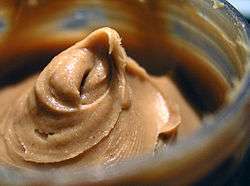 "Smooth" peanut butter in a jar | |
| Type | Spread |
|---|---|
| Main ingredients | Peanuts (commercial brands also often contain salt, a sweetener such as sugar, and an emulsifier or vegetable oil) |
Peanut butter is a food paste or spread made from ground dry roasted peanuts. It often contains additional ingredients that modify the taste or texture, such as salt, sweeteners or emulsifiers. Peanut butter is popular in many countries. The United States[1] is a leading exporter of peanut butter and itself consumes $800 million of peanut butter annually.[2]
Peanut butter is served as a spread on bread, toast or crackers, and used to make sandwiches (notably the peanut butter and jelly sandwich). It is also used in a number of confections, such as peanut-flavoured granola bars or croissants and other pastries. A variety of other nut butters are also sold, such as cashew butter and almond butter, produced in comparable ways.
History
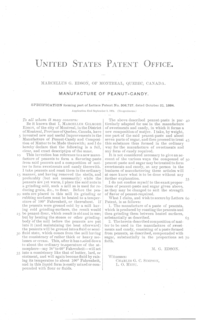
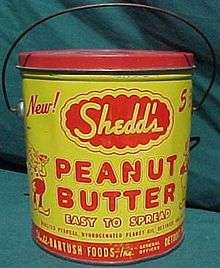
The use of peanuts dates to the Aztecs and Incas,[3][4] and peanut paste may have been used by the Aztecs as a toothache remedy in the first century of the Common Era (CE).[5][6]
Marcellus Gilmore Edson (1849 – 1940) of Montreal, Quebec, Canada obtained a patent for peanut butter in 1884.[7] Edson's cooled product had "a consistency like that of butter, lard, or ointment" according to his patent application which described a process of milling roasted peanuts until the peanuts reached "a fluid or semi-fluid state". He mixed sugar into the paste to harden its consistency. A businessperson from St. Louis named George Bayle produced and sold peanut butter in the form of a snack food in 1894.[8]
John Harvey Kellogg, known for his line of prepared breakfast cereals, was issued a patent for a "Process of Producing Alimentary Products" in 1898, and used peanuts, although he boiled the peanuts rather than roasting them.[9] Kellogg's Western Health Reform Institute served peanut butter to patients because they needed a food that contained a lot of protein, yet which could be eaten without chewing.[8] At first, peanut butter was a food for wealthy people, as it became popular initially as a product served at expensive health care institutes.[8]
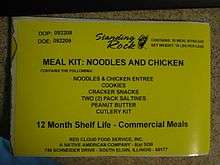
Early peanut-butter-making machines were developed by Joseph Lambert, who had worked at John Harvey Kellogg's Battle Creek Sanitarium, and Dr. Ambrose Straub who obtained a patent for a peanut-butter-making machine in 1903.[6][10] "In 1922, chemist Joseph Rosefield invented a process for making smooth peanut butter that kept the oil from separating by using partially hydrogenated oil"; Rosefield "...licensed his invention to the company that created Peter Pan peanut butter" in 1928 and in "...1932 he began producing his own peanut butter under the name Skippy".[6] Under the Skippy brand, Rosefield developed a new method of churning creamy peanut butter, giving it a smoother consistency. He also mixed fragments of peanut into peanut butter, creating the first "chunky"-style peanut butter.[8] In 1955, Procter & Gamble launched a peanut butter named Jif, which was sweeter than other brands, due to the use of "sugar and molasses" in its recipe.[8]
As the US National Peanut Board confirms, "Contrary to popular belief, George Washington Carver did not invent peanut butter."[11] Carver was given credit in popular folklore for many inventions that did not come out of his lab. By the time Carver published his document about peanuts, entitled "How to Grow the Peanut and 105 Ways of Preparing it For Human Consumption" in 1916,[12] many methods of preparation of peanut butter had been developed or patented by various pharmacists, doctors and food scientists working in the US and Canada.[13][14][10] January 24 is National Peanut Butter Day in the United States.[15]
Types
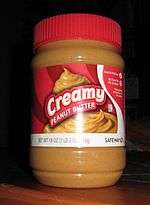
The two main types of peanut butter are crunchy (or chunky[16]) and smooth. In crunchy peanut butter, some coarsely-ground peanut fragments are included to give extra texture. The peanuts in smooth peanut butter are ground uniformly, creating a creamy texture.
In the US, food regulations require that any product labelled "peanut butter" must contain at least 90% peanuts;[17] the remaining <10% usually consists of "...salt, a sweetener, and an emulsifier or hardened vegetable oil which prevents the peanut oil from separating".[18] In the US, no product labelled as "peanut butter" can contain "artificial sweeteners, chemical preservatives, [or] natural or artificial coloring additives."[18] Some brands of peanut butter are sold without emulsifiers that bind the peanut oils with the peanut paste, and so require stirring after separation. Most major brands of peanut butter add white sugar, but there are others that use dried cane syrup, agave syrup or coconut palm sugar.[19]
Organic and artisanal peanut butters are available, but their markets are small.[8][20]
Production process
Planting and harvesting
(NRCS_Photo_Gallery).tif.jpg)
Due to weather conditions, peanuts are usually planted in Spring. The peanut comes from a yellow flower which bends over and infiltrates the soil after blooming and wilting, and the peanut starts to grow in the soil. Peanuts are harvested from late August to October, while the weather is clear.[21] This weather allows for dry soil so that when picked, the soil does not stick to the stems and pods. The peanuts are then removed from vines and transported to a peanut shelling machine for mechanical drying. After cropping, the peanuts are delivered to warehouses for cleaning, where they are stored unshelled in silos.[21]
Shelling
The most important thing about shelling is to remove the shell of peanuts with the smallest damage to the seed. The moisture of the unshelled peanuts is controlled to avoid excessive frangibility of the shells and kernels, which in turn, reduces the amount of dust present in the plant.[21] After, the peanuts are sent to a series of rollers set specifically for the batch of peanuts, where they are cracked. After cracking, the peanuts go through a screening process where they are inspected for contaminants.[21]
Roasting
The dry roasting process employs either the batch or continuous method. In the batch method, peanuts are heated in large quantities in a revolving oven at about 800 °F (427 °C).[22] Next, the peanuts in each batch are uniformly held and roasted in the oven at 320 °F (160 °C) for about 40 to 60 minutes.[21] This method is good to use when the peanuts differ in moisture content. In the continuous method, a hot air roaster is employed. The peanuts pass through the roaster whilst being rocked to permit even roasting. A photometer indicates the completion of dry roasting.[23] This method is favoured by large manufacturers since it can lower the rate of spoilage and requires less labor.[21]
Cooling
After dry roasting, peanuts are removed from the oven as quickly as possible and directly placed in a blower-cooler cylinder.[21] There are suction fans in the metal cylinder that can pull a large volume of air through,[23] so the peanuts can be cooled more efficiently. The peanuts will not be dried out because cooling can help retain some oil and moisture.[23] The cooling process is completed when the temperature in the cylinder reaches 86 °F (30 °C).[21]
Blanching
After the kernels have been cooled down, the peanuts will undergo either heat blanching or water blanching to remove the remaining seed coats. Compared to heat blanching, water blanching is a new process. Water blanching first appeared in 1949.[21]
Heat blanching
Peanuts are heated by hot air at 280 °F (138 °C) for not more than 20 minutes in order to soften and split the skins. After that, the peanuts are exposed to continuous steam in a blanching machine. The skins are then removed using either bristles or soft rubber belts. After that, these skins are separated and blown into waste bags. Meanwhile, the hearts of peanuts are segregated through inspection.[21]
Water blanching
After the kernels are arranged in troughs, the skin of the kernel is cracked on opposite sides by rolling it through sharp stationary blades. While the skins are removed, the kernels are brought through a one-minute hot water bath and placed on a swinging pad with canvas on top. The swinging action of the pad rubs off the skins. Afterward, the blanched kernels are dried for at least six hours by hot air at 120 °F (49 °C).[21]
After blanching, the peanuts are screened and inspected to eliminate the burnt and rotten peanuts. A blower is also used to remove light peanuts and discoloured peanuts are removed using a colour sorting machine.[21]
Grinding
After blanching the peanuts are sent to grinding to be manufactured into peanut butter. The peanuts are then sent through two sizes of grinders. The first grinder produces a medium grind, and the second produces a fine grind.[21] At this point, salt, and a vegetable oil stabilizer are added to the fine grind to produce the peanut butter. This adds flavour and allows the peanut butter to stay as a homogenous mixture.[24] Chopped peanuts may also be added at this stage to produce “chunky” peanut butter.[21]
Packaging
Before packaging, the peanut butter must first be cooled in order to be sealed in jars.[21] The mixture is pumped into a heat exchanger[24] in order to cool it to about 120 °F (49 °C). Once cool, the peanut butter is pumped into jars and vacuum sealed. This vacuum sealing rids the container of oxygen so that oxidation cannot occur, preserving the food. The jars are then labelled and set aside until crystallization occurs. The peanut butter is then packaged into cartons distributed to retailers, where they are stored at room temperature and sold to consumers.[21]
A 2012 article stated that "China and India are the first and second largest producers, respectively", of peanuts.[6] The United States of America "...is the third largest producer of peanuts (Georgia and Texas are the two major peanut-producing states)"[6] and "more than half of the American peanut crop goes into making peanut butter."[6]
Health
Nutritional profile
| Nutritional value per 100 g (3.5 oz) | |
|---|---|
| Energy | 2,462 kJ (588 kcal) |
|
20 g | |
| Starch | 4.8 g |
| Sugars | 9.2 g |
| Dietary fiber | 6 g |
|
50 g | |
|
25 g | |
| Vitamins | Quantity %DV† |
| Thiamine (B1) |
10% 0.11 mg |
| Riboflavin (B2) |
9% 0.11 mg |
| Niacin (B3) |
88% 13.2 mg |
| Pantothenic acid (B5) |
22% 1.1 mg |
| Vitamin B6 |
42% 0.55 mg |
| Folate (B9) |
9% 35 μg |
| Vitamin E |
39% 5.9 mg |
| Minerals | Quantity %DV† |
| Calcium |
5% 54 mg |
| Iron |
17% 2.2 mg |
| Magnesium |
50% 179 mg |
| Manganese |
71% 1.5 mg |
| Phosphorus |
48% 335 mg |
| Potassium |
14% 649 mg |
| Sodium |
0% 0 mg |
| Zinc |
28% 2.7 mg |
| Other constituents | Quantity |
| Water | 1.8 g |
| Alcohol (ethanol) | 0 g |
| Caffeine | 0 mg |
| |
|
†Percentages are roughly approximated using US recommendations for adults. Source: USDA Nutrient Database | |
In a 100 gram amount, smooth peanut butter supplies 588 Calories and is composed of 50% fat, 25% protein, 20% carbohydrates (including 6% dietary fiber), and 2% water (table).
Peanut butter is a rich source (20% or more of the Daily Value, DV) of dietary fiber, vitamin E, pantothenic acid, niacin, and vitamin B6 (table, USDA National Nutrient Database).[25][26] Also high in content are the dietary minerals manganese, magnesium, phosphorus, zinc, and copper (table).[25][26] Peanut butter is a moderate source (10–19% DV) of thiamin, iron, and potassium (table).[25][26]
Both crunchy/chunky and smooth peanut butter are sources of saturated (primarily palmitic acid, 21% of total fat) and monounsaturated fats, mainly oleic acid as 47% of total fat, and polyunsaturated fat (28% of total fat), primarily as linoleic acid).[26]
Peanut allergy
For people with a peanut allergy, peanut butter can cause a variety of possible allergic reactions, including life-threatening anaphylaxis.[27] This potential effect has led to banning peanut butter, among other common foods, in some schools.[28][29]
Other uses
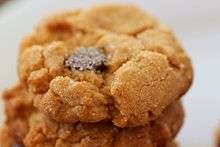
As an ingredient
.jpg)
Peanut butter is included as an ingredient in many recipes: peanut butter and jelly sandwiches, peanut butter cookies, and candies where peanut is the main flavour, such as Reese's Pieces, or various peanut butter and chocolate treats, such as Reese's Peanut Butter Cups and the Crispy Crunch candy bar.
Peanut butter's flavor combines well with other flavors, such as oatmeal, cheese, cured meats, savory sauces, and various types of breads and crackers. The creamy or crunchy, fatty, salty taste pairs very well with complementary soft and sweet ingredients like fruit preserves, bananas, apples, and honey. The taste can also be enhanced by similarly salty things like bacon (see peanut butter, banana and bacon sandwich), especially if the peanut butter has added sweetness.
One snack for children is called "Ants on a Log", with a celery stick acting as the "log". The groove in the celery stick is filled with peanut butter and raisins arranged in a row along the top are "ants".[30]
Plumpy'nut is a peanut butter-based food used to fight malnutrition in famine-stricken countries. A single pack contains 500 calories, can be stored unrefrigerated for 2 years, and requires no cooking or preparation.[31]
As animal food
Peanut butter inside a hollow chew toy is a method to occupy a dog with a favored treat.[32] A common outdoor bird feeder is a coating of peanut butter on a pine cone with an overlying layer of birdseed.[33]
Other names
A slang term for peanut butter in World War II was "monkey butter".[34] In the Netherlands peanut butter is called pindakaas (literally "peanut cheese") rather than pindaboter ("peanut butter") because the word butter was a legally protected term for products that contain actual butter, prompting Calvé, the company which first marketed it in the country in 1948, to use kaas instead.[35] In the US, food regulations require that "peanut butter" must contain at least 90% peanuts, otherwise it must be called "peanut spread".[17]
See also
- Artisan peanut butter
- Hazelnut butter
- List of peanut dishes – includes dishes that use peanut butter as a main ingredient
- List of spreads
- Peanut pie
- Peanut sauce
- Sesame butter
- Sunflower butter

References
- ↑ "U.S. Exports of (NAICS 311911) Roasted Nuts & Peanut Butter With All Countries]". US Census Bureau. 2012. Archived from the original on June 19, 2015.
- ↑ Chakravorty, Rup. "Breeding a better peanut butter". American Society of Agronomy. Archived from the original on November 10, 2015. Retrieved October 15, 2015.
- ↑ Bureau, Commodity Research (August 24, 2007). "The CRB Commodity Yearbook 2007". John Wiley & Sons. Archived from the original on December 3, 2017. Retrieved September 29, 2016 – via Google Books.
- ↑ Christopher Cumo. Foods That Changed History: How Foods Shaped Civilization from the Ancient World to the Present. ABC-CLIO. p. 284. Archived from the original on June 10, 2016.
- ↑ Cumo, Christopher (2015). The Ongoing Columbian Exchange: Stories of Biological and Economic Transfer in World History: Stories of Biological and Economic Transfer in World History. ABC-CLIO. p. 146.
- 1 2 3 4 5 6 "The History of Peanut Butter". Huffington Post. August 31, 2012. Archived from the original on September 26, 2016. Retrieved October 3, 2016.
The Aztecs mashed roasted peanuts into a paste, somewhat different from what we know of as peanut butter today.
- ↑ "Manufacture of peanut candy, US Patent #306727". US Patent Office. October 21, 1884. Archived from the original on April 5, 2017. Retrieved May 8, 2017.
- 1 2 3 4 5 6 Michaud, Jon (November 28, 2012). "A chunky history of peanut butter". www.newyorker.com. New Yorker. Archived from the original on March 31, 2017. Retrieved May 9, 2017.
- ↑ "Process of producing alimentary products, US Patent #604493". US Patent Office. May 24, 1898. Archived from the original on April 5, 2017. Retrieved May 8, 2017.
- 1 2 Innovate St. Louis (August 25, 2011). "Innovation in St. Louis History – Innovate St. Louis". Innovatestl.org. Archived from the original on December 27, 2011. Retrieved December 18, 2011.
- ↑ National Peanut Board, Who Invented Peanut Butter?, archived from the original on November 25, 2016, retrieved November 24, 2016.
- ↑ "George Washington Carver" Archived November 1, 2015, at the Wayback Machine., National Peanut Board.
- ↑ "US Patent #306727". Archived from the original on February 18, 2017.
- ↑ "US Patent #604493". Archived from the original on April 5, 2017.
- ↑ "American Holidays – United States National Holidays". Statesymbolsusa.org. Archived from the original on December 17, 2011. Retrieved December 18, 2011.
- ↑ Spiegel, Alison (July 23, 2014). "Smooth vs. Chunky Peanut Butter: The Great Debate". Archived from the original on October 2, 2016. Retrieved September 29, 2016.
- 1 2 Blitz, Matthew (October 14, 2015). "Why Midcentury Lawyers Spent 12 Years Arguing About Peanut Butter". Atlas Obscura. Archived from the original on October 15, 2015. Retrieved October 15, 2015.
- 1 2 Rosengarten, Jr., Frederic (2004). The Book of Edible Nuts. Courier Corporation. p. 162.
- ↑ Patel, Arti (September 21, 2015). "Sugar In Peanut Butter: What Type Of Sugar Are You Eating?". Huffington Post Canada. Archived from the original on October 5, 2016. Retrieved October 3, 2016.
- ↑ Wright, Simon (2012). Handbook of Organic Food Processing and Production. Springer Science & Business Media. p. 129.
- 1 2 3 4 5 6 7 8 9 10 11 12 13 14 15 16 "How peanut butter is made - material, ingredients of, manufacture, making, used, processing, parts". www.madehow.com. Archived from the original on August 11, 2017. Retrieved August 11, 2017.
- ↑ "AP 42 Compilation of Air Pollutant Emission Factors § 9.10.2.2 Peanut Processing" (pdf). United States Environmental Protection Agency. January 1995. Retrieved August 8, 2018.
- 1 2 3 "Archived copy" (PDF). Archived (PDF) from the original on August 11, 2017. Retrieved August 11, 2017.
- 1 2 "Subject Matter: Making Peanut Butter - IFT.org". www.ift.org. Archived from the original on August 11, 2017. Retrieved August 11, 2017.
- 1 2 3 "Basic Report: 16167, USDA Commodity, Peanut Butter, smooth per 100 g". US Department of Agriculture, National Nutrient Database, version SR-27. 2014. Archived from the original on October 29, 2015. Retrieved May 3, 2015.
- 1 2 3 4 "Nutrition facts for peanut butter, smooth style, without salt per 100 g". Conde Nast for USDA National Nutrient Database, version SR-21. 2014. Archived from the original on May 6, 2015. Retrieved May 3, 2015.
- ↑ "Food allergies in schools". Centers for Disease Control, US Department of Health and Human Services. 2015. Archived from the original on April 29, 2015. Retrieved May 3, 2015.
- ↑ James Barron (September 27, 1998). "Dear Mr. Carver. This Is a Cease and Desist Order". New York Times. Archived from the original on September 10, 2010.
- ↑ Labi S (January 31, 2010). "Schools' banned food list has gone nuts". The Daily Telegraph, Sydney, Australia. Retrieved May 3, 2015.
- ↑ "Kids' Recipe: Ants on a Log". Fit.webmd.com. April 24, 2012. Archived from the original on October 13, 2013. Retrieved October 19, 2013.
- ↑ Michael Wines (August 8, 2005). "Hope for Hungry Children, Arriving in a Foil Packet". The New York Times. Archived from the original on December 19, 2013.
- ↑ "KONG and Other Food Puzzle Toys for Dogs: Usage and Recipes". Pets.webmd.com. Archived from the original on October 12, 2013. Retrieved October 19, 2013.
- ↑ "Pine Cone Bird Feeder". Wisconsin State Environmental Education for Kids!. Archived from the original on February 11, 2009.
- ↑ Jacobs, Jay (1995). The Eaten Word: The Language of Food, the Food in Our Language. Carol Publishing Corporation. ISBN 1-55972-285-1.
- ↑ Der Nederlanden: Calvé, pindakaas van;Calvinisme Archived November 4, 2016, at the Wayback Machine., Volkskrant, October 30, 2010
Further reading
- Krampner, Jon (2013). Creamy and Crunchy: An Informal History of Peanut Butter, the All-American Food. Columbia University Press. ISBN 9780231530934.